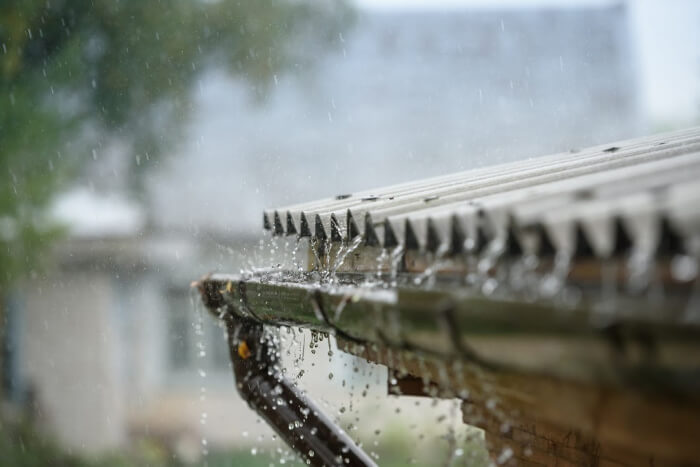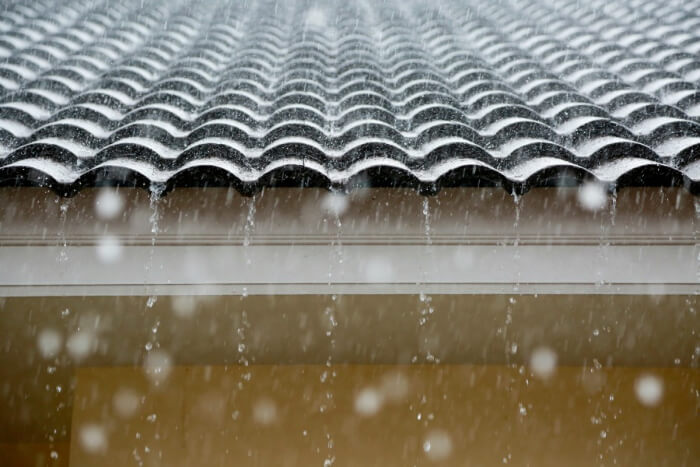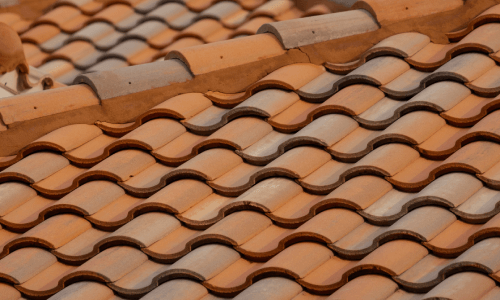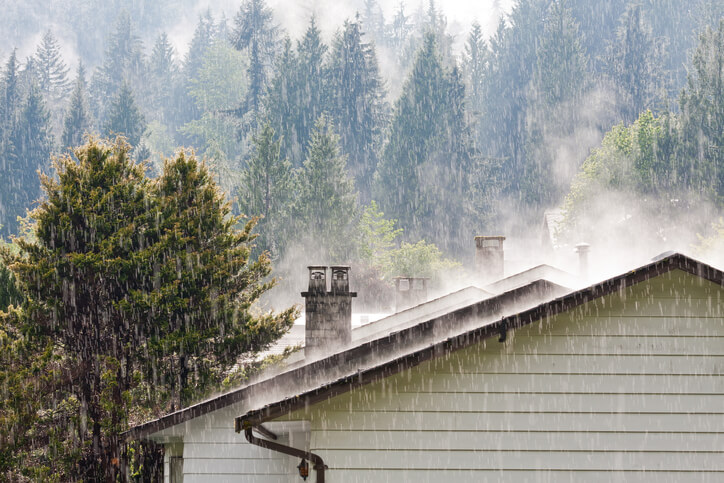Are you doing a roofing project?
Modernize can pair you with three to four pros in your area, so you can compare options and save time and money.
- Before You Contact Your Homeowners Insurance
- Types of Homeowner Insurance Coverage
- What is Usually Covered by Homeowners Insurance…And What’s Not
- Filing a Homeowners Insurance Claim for Home Damage
- Understanding Your Deductible
- Meeting With Local Roofing Contractors
- Beware of Scams
- Meet With Your Insurance Adjuster
- Hire Your Preferred Contractor to Repair Roof Damage
Your roof is often the first line of defense your home has against the elements, but severe weather, like hurricanes, tornados, and hail, can damage the roof to your home — causing leaks, water, and structural damage. To quickly, safely, and affordably repair roofing damage, you may need to file a homeowners insurance claim. We know, for years of homeowner surveys, that homeowners seeking roofing repairs/replacements are more stressed than homeowners pursuing any other project. To help, we’ve created a series of articles and tools for you to use to feel as in control of and knowledgeable about this process. This article is the third in our series, following spotting roof damage from a storm and how to hire a contractor (which includes a digital checklist). Here, we will assist you as you navigate insurance claims, contractors, and the repair process.

Before You Contact Your Homeowners Insurance
Before contacting your insurance agent, take time to document the damage to your roof. Take multiple pictures of the interior and exterior of your home, as well as detailed notes. If the damage was caused by a storm, document the date and time.
If damage occurred from hail, it’s smart to document the size of the hail with a tape measurer. After documenting the damage, safe-proof your home to prevent further damage before contacting your insurance.
Types of Homeowner Insurance Coverage
There are usually four main coverage types to your homeowners insurance:
- Dwelling Insurance
- This protects the structure of your home, including your windows, garage, and built-in appliances like your water heater or HVAC. This coverage may help pay for the rebuilding or the repair of the physical structure of your home if it’s damaged by natural disaster, theft, or vandalism.
- Personal Property Insurance
- This covers your personal belongings, like furniture, clothing, electronics, jewelry, and kitchen appliances. This type of coverage, designed to help protect your belongings, may help provide protection in the event of a covered loss, such as theft or fire.
- Liability Insurance
- This coverage assists if someone has been hurt or injured on your property, like a dog bite or falling off a ladder.
- Additional Living Expenses (ALE) Insurance
- If your home is uninhabitable after an event, this helps cover temporary housing cost.
You can learn how these coverages protect you and your home on your homeowner insurance policy declaration page. Your declaration page will outline both your personal information and the coverage details.
What is Usually Covered by Homeowners Insurance…And What’s Not
According to the Insurance Information Institute, standard homeowners policies cover a wide range of potential disasters including tornadoes, lightning strikes, fire, wind, hail, and falling objects. But it’s important to note that not all natural disasters are covered in your policy.
Like many insurance providers, Allstate notes that damage caused by floods and earthquakes are not typically part of your homeowners insurance policy. However, they are often available through additional policies. Check with your insurance provider to learn if they offer these protections.
Normal wear and tear on your home and damage due to lack of maintenance, mold, or infestation from termites or other pests are also not usually covered.
Filing a Homeowners Insurance Claim for Home Damage
Storm damage to your home will fall under your dwelling insurance. Damage may impact your roof, walls, windows, floors, foundation, or built-in appliances like your air conditioning unit. Once you have documented the damage, and taken action to prevent further damage, you can begin the claims process. It is important to file a claim as soon as possible after an event.
Most companies make it easy for homeowners to navigate this process on their website or mobile app, but you can also call the number listed on your policy. To submit a claim, you will need your policy number and an explanation/summary of damages. Your insurance agent will discuss your current policy, what’s covered and your next steps.
Understanding Your Deductible
It is important to understand your homeowners insurance deductible throughout this process. This deductible is the amount you will have to pay before receiving a reimbursement from your insurance provider.
Find the Right Contractor for Your Roofing Project
Whether you’re ready to begin your project now or need some expert advice, our network of contractors are here to help. With a few simple questions, we’ll find the best local professionals for you
For example, if your deductible is $1,000, but the cost to repair your roof is $800, your deductible would not be met. You would not receive any money back from your insurance company. In this case, you may choose to repair the roof on your own.
If it costs $3,000 to repair your damaged roof, and your deductible is $1,000, you would file a claim and pay your deductible. Your insurance provider would cover the additional $2,000 cost. A typical roof repair runs between $150 and $3,000 depending on the size of damage and materials. Roof replacements range from $8,000 to $17,500.
Meeting With Local Roofing Contractors
After filing a claim, you will be asked to schedule an appointment with an insurance adjuster. Before meeting with the adjuster, we recommend receiving three to four project estimates from local, trusted contractors. These contractors should provide free estimates, but not begin any repairs yet. Keep all of the estimates and any additional relevant paperwork organized. You will share these details with your insurance adjuster at your meeting.
Make sure you don’t sign a contract or agreement or make any type of payment until your insurance provider has approved the estimate. It is important not begin repairs until after the adjuster has inspected your home, as that may lead to not receiving compensation.
If possible, ask your roofing contractor to be present at your appointment with the insurance adjuster. This will protect you from any overlooked damages and will also ensure that you get a fair assessment.

Beware of Scams
While most contractors are reliable, there are scammers who seek out neighborhoods with a high percentage of senior citizens; areas with older housing stock; and places that are prone to, or were recently hit by major storms.
While many contractors are honest professionals, others are not. After a natural disaster, be aware of scammers who often go door-to-door in affected neighborhoods promising repairs. These dishonest individuals often take homeowner’s money or insurance settlements without completing the job or use cheap and defective materials. These individuals may also attempt to manipulate your insurance deductible which is insurance fraud— a felony that may render your insurance coverage void.
Meet With Your Insurance Adjuster
After receiving your contractor estimates, make an appointment with your insurance adjuster. They will help determine the cause of damage and assess the total cost. When the adjuster meets you at your home, they will ask you about the event. This is where your detailed notes will be important. The adjuster will create a report that contains a description of the roof damage, as well as photos. It is also important to share the estimates you received from contractors at this meeting. All of these details will be submitted to the insurance company to move your claim along.
Hire Your Preferred Contractor to Repair Roof Damage
Once your claim has been approved, and you have reached a settlement for the cost of repairs, begin working with your preferred, licensed contractor to repair your roof. Your insurance provider will typically send an advance for half of the payment to allow you to begin repairs. The last half will be sent upon completion, minus your deductible.
Already know you have home storm damage? We can help. Receive up to four quotes from reliable roofing contractors in your area.
Find the Right Contractor for Your Roofing Project
Whether you’re ready to begin your project now or need some expert advice, our network of contractors are here to help. With a few simple questions, we’ll find the best local professionals for you
Reviews from Real Homeowners
Welcome to Homeowner Resources! We are the Modernize blog. Modernize pairs more than 3 million homeowners a year with pre-vetted contractors in their area. This blog started because we believe homeowners should know everything about their homes, from how their HVAC works to which front door colors they might love. On Homeowner Resources, you can find information on every part of your home, right down to how you can negotiate with contractors to get the best price. Here's more about the blog.
Need a contractor? Learn more about how Modernize finds the right pro for you.






